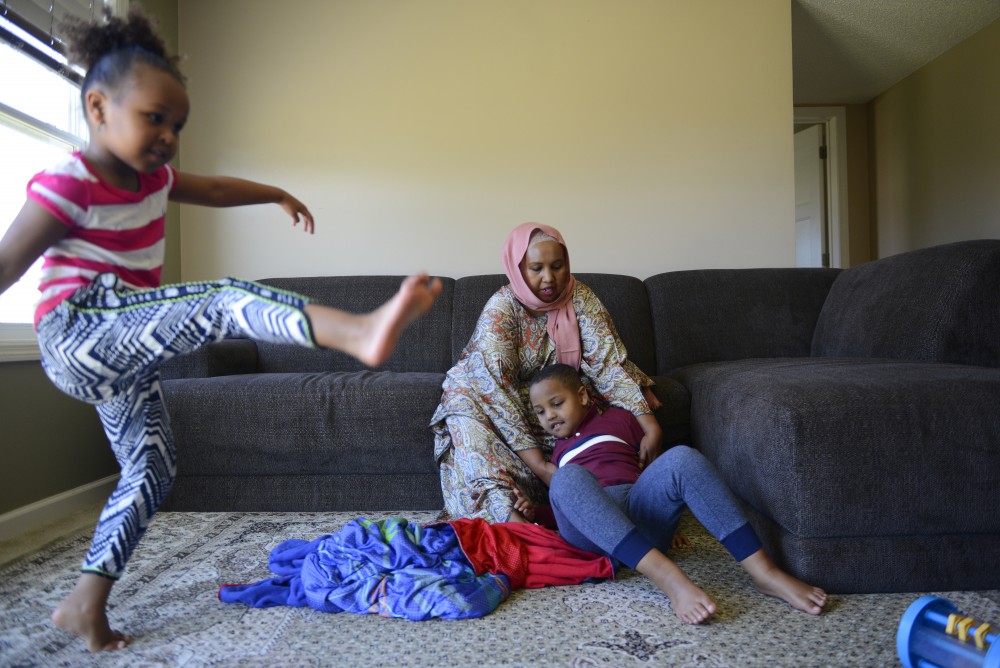Six-year-old Anas Ahmed could hardly be contained as he bolted across his playroom.
His mother, Marian Ahmed, called Anas over, taking his head between her hands and squeezing gently.
The pressure calms Anas from uncontrollable excitement often associated with severe autism — a disorder he was diagnosed with shortly after his first birthday.
Of Ahmed’s four children, both of her sons — Anas and his eight-year-old brother, Ayub — have autism spectrum disorders. While Ayub’s condition has improved with age, Anas continues to struggle with autism.
The family’s story is not unusual in Minneapolis’ Somali community, where many parents struggle to comprehend a disorder cloistered by cultural barriers.
“Within the East African community, people are not really talking about this,” said Ward 6 Minneapolis City Council Member Abdi Warsame.
A shortage of information on autism spectrum disorders has also spawned stigma within the Somali community. While many affected families struggle to find appropriate care for their children, University of Minnesota researchers are working to better understand the scope and cultural impact of the disorder on Minneapolis’ East African population.

Navigating tricky, cultural terrain
In Somalia, confusion leads some to believe that those affected by autism are crazy, Ahmed said.
“In our language, there’s no word [for autism],” she said.
Those worries have extended into Minnesota’s Somali community, where the disorder is highly stigmatized, said Asli Ashkir, senior RN consultant with the Minnesota Department of Health.
A University of Minnesota study showed that in 2010, one in 32 Somali children in Minneapolis had autism, compared to the city’s overall rate of one in 48.
For some, the disorder is yet another concern in a community dealing with high poverty and unemployment rates.
“Personally, it’s very evident of the prevalence — without even looking at the study — by looking at our community and families. There is not one person that was not touched by autism,” said Mariam Egal, multicultural outreach and education coordinator for Minnesota Department of Human Services’ disability services division.

Initially, many in the community were skeptical about the findings of the University’s study, Warsame said.
Since autism is rarely diagnosed in Somalia, he said parents wondered if something in the U.S. caused the disorder such as food, environmental factors or vaccines.
“It’s a disorder or a human disease that is associated with the immigration to the West because it was something that was diagnosed when people immigrated here,” Warsame said.
Abdullahi Farah vaccinated both of his sons at a young age before they were diagnosed with severe autism.
“Both my kids, when they got that shot, they changed their behavior,” Farah said.
Mohmed Salad, 23, and Ibrahim Salad, 17, both live at home with Farah and his wife.
Warsame said many Minneapolis Somalis are concerned about vaccinations.
A report from the Minnesota Department of Health found that 45 percent of Somali children in Minnesota received the measles, mumps and rubella vaccination in 2013, which was down from 92 percent in 2004.

Ashkir said MDH works to educate the community about autism and dispel fears about how children develop the disorder.
When parents ask about the link between the MMR vaccine and autism, she shows them various research studies that have disproved the association.
This training has helped to alleviate fears within the community.
“We have seen converts immediately in the training,” Ashkir said.
Despite outreach, some parents keep their children in the house and away from the judgment of others — hoping to stave off labels of mental health issues imposed on their children, Ashkir said.
“I remember I used to hide from my neighbors. My parents, my mom, my dad — I never told them anything,” Ahmed said. “I went through a lot of depression.”
It took a couple years to come to terms with her sons’ autism, she said. Similar situations have caused other parents to defer immediate treatment as they work to understand their child’s diagnosis, Ahmed said.
Ashkir, the MDH consultant, said many parents call her instead of their health care provider because they fear further stigmatization.
To instill trust, Ashkir said nurses, family doctors and pediatricians are undergoing training to be more conscientious of cultural sensitivities.
Minnesota DHS is conducting similar outreach in the Somali community, Egal said, which involves creating support groups for parents to share their experiences.
Autism’s growing national prevalence

Data collected over the last 16 years has shown a spike in cases of autism spectrum disorders nationwide, according to the Centers for Disease Control and Prevention.
Amy Hewitt, lead author of the University’s 2013 study, said there are many theories about the increase, though no one has pinpointed a specific reason.“One theory is that there is a lot more effort around screening and prevention and getting the word out about autism and autism spectrum disorders,” she said. “And with that increased … attention, more kids are being screened, and more kids are getting service.”
Others, however, think the nationwide increase is due to an increased population, Hewitt said, which she also believes may contribute to autism in the Somali community.
Still, the verifiable science on the subject is limited.
“The only study that’s been done in the United States … specifically about Somali prevalence, is the one that we did,” Hewitt said.
A follow-up study, which Hewitt started this year, aims to confirm the diagnosis rate cited in the 2013 study, she said.
Part of the analysis, Hewitt said, includes conducting family interviews and observations.
The new research is a small step toward determining the cause of the heightened prevalence of autism spectrum disorders in the Somali community, she said, adding that it’s harder to get funding for a follow-up study because of the small size of the population.
“We have to incrementally build an argument to get to the kind of resource that’s needed to do a big enough study that would look at potential causes,” Hewitt said.

Ongoing efforts
Community members and advocates don’t necessarily see further research as a solution to the growing problem.
Ahmed said she isn’t interested in a follow-up study since it won’t help children already dealing with the everyday struggles of autism.
“It’s just wasting of money,” she said.
Instead, Ahmed said she’d like to see funding go toward educating more parents who struggle to care for children with autism spectrum disorders.
Councilman Warsame agreed: “Nobody’s really talking about it,” he said. “We’re not engaging our residents where they can get help, how they can get support.”
And while his office has worked to create awareness for the disorder, there wasn’t much attention from the city itself, he said.
As a result, Warsame said he pushed for city funding to help parents.. He succeeded, and $20,000 was placed on Minneapolis’ budget last year to promote autism awareness and help fund support groups.
“Within the city enterprise, it wasn’t a big deal,” he said. “This was the first time autism was brought up to the top.”
The Somali Parents Autism Network (SPAN), which started in 2013 as a support group for parents struggling with their kids’ autism, received some of the funding for outreach, Ahmed said.
Since its inception, the group has quickly grown.
“The support group now … is a full-blown organization,” Egal, the DHS outreach and education coordinator, said.
The funding helped the group distribute information and share food at mosques, allowing parents to share their experiences, Ahmed, also a founder and executive director of SPAN, said.
Warsame said the city also launched a program last month with the Minneapolis Fire Department to help track down missing children and vulnerable adults. The SafetyNet Tracking Systems program provides bracelets with unique digital ID numbers and frequencies that fire trucks can detect.
Farah said having a tool to track his sons’ whereabouts is advantageous since his kids sometimes try to run away. His son once left school and took the light rail to the Mall of America and was later found by police, Farah said.
Ahmed said she already ordered the bracelets for her children.
Right now, she said she has an alarm system and locks on every door to make sure her children can’t get out.
But other parents aren’t as lucky, she said, and don’t have the same safeguards. Some parents alternate shifts watching their kids each night because they can’t lock their doors, Ahmed said.
“When you’re up every night, it’s hard,” Ahmed said. “You have a short [temper].”
The wristband program is one effort that could aid parents of children with autism in the Somali community, and Warsame said he thinks it will ease parents’ worries about their children wandering off.











